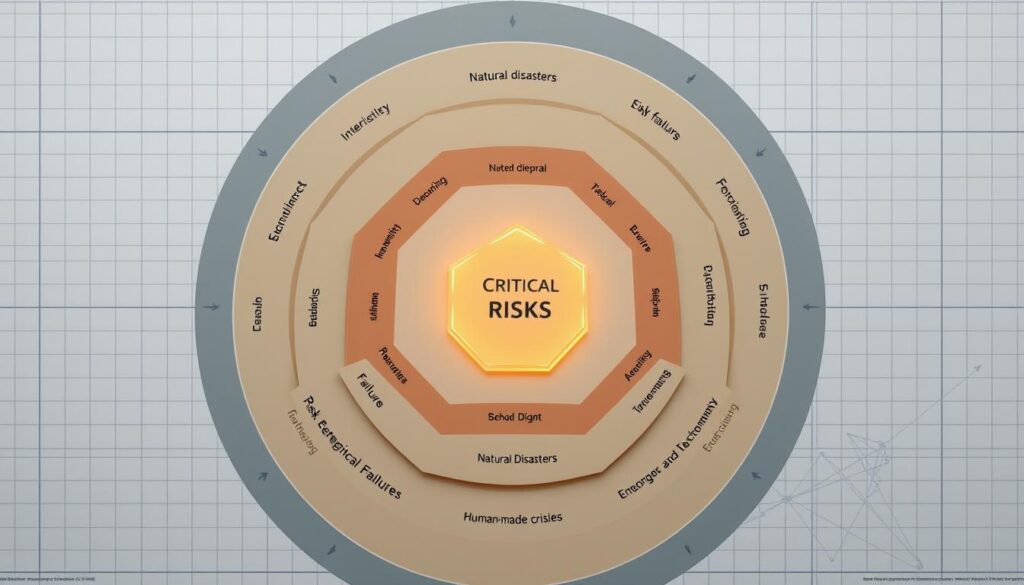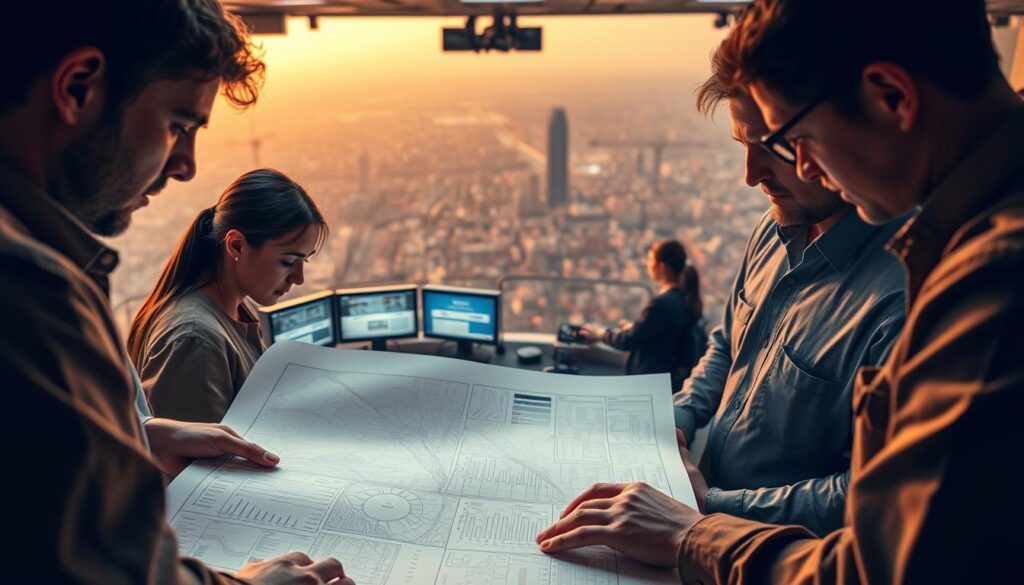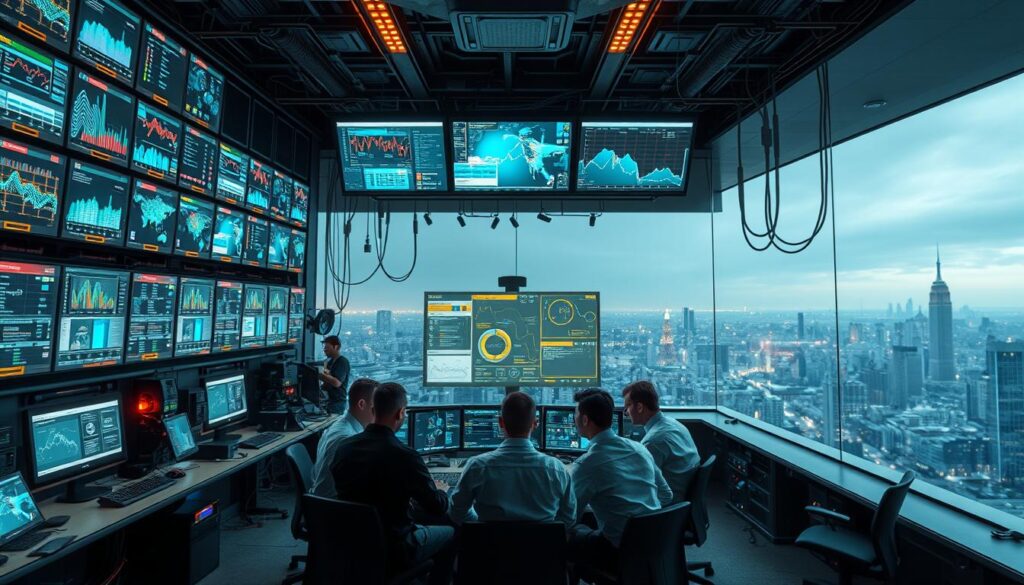Thinking about emergencies, I see how they can happen anytime, affecting people and things. It’s key for businesses and communities to have a plan to deal with these risks.
A good plan can really help. Experts say every business should have an emergency plan. This plan helps protect everyone, from employees to visitors. It’s about knowing the risks and acting early to avoid them.
By planning ahead, we can quickly and effectively handle emergencies. This helps keep our operations running smoothly and our community safe.
Key Takeaways
- Understand the importance of emergency planning
- Identify possible risks and threats
- Develop a detailed emergency management strategy
- Take steps to lessen risks
- Keep the emergency plan up to date
Understanding the Importance of Strategic Planning in Emergencies
Effective strategic planning is key to being ready for disasters. It’s not just good to be prepared; it’s essential for saving lives and lessening damage.
The Benefits of Being Prepared
Being ready for emergencies offers many advantages. It means quick action and warnings that can save lives and protect buildings and property. With a strategic plan, people and groups can respond better, staying strong against disasters.
Some main benefits of being prepared include:
- Enhanced safety and reduced risk of injury or death
- Minimized damage to property and infrastructure
- Faster recovery times due to well-planned response strategies
- Improved resilience through effective crisis management
Common Types of Emergencies
Emergencies come in many forms, from natural disasters like hurricanes and earthquakes to man-made crises like industrial accidents or cyber-attacks. Knowing the types of emergencies is key to crisis response planning.
| Type of Emergency | Characteristics | Preparedness Measures |
|---|---|---|
| Natural Disasters | Unpredictable, widespread destruction | Early warning systems, evacuation plans |
| Industrial Accidents | Potential for chemical releases, explosions | Safety protocols, emergency response training |
| Cyber-attacks | Data breaches, system downtime | Cybersecurity measures, incident response plans |
How Strategic Planning Mitigates Risks
Strategic planning is vital in reducing risks during emergencies. By doing thorough risk assessments and creating disaster preparedness tactics, we can lower the chance and impact of emergencies.
A good strategic plan helps spot risks, use resources well, and make sure responses are smooth and effective.
Assessing Emergency Risks and Threats
Emergency planning starts with checking out possible risks and threats. This step is key to making effective emergency strategies. These strategies help lessen the effects of unexpected events. It’s important to make a plan that fits your organization’s specific needs.

Identifying the Most Common Risks
The first thing to do is find out what kinds of emergencies could hit your organization. These might include natural disasters like hurricanes or earthquakes, or man-made crises like cyber-attacks. For example, places prone to flooding should focus on flood risks. Knowing these risks helps you start making effective emergency plans.
Evaluating the Likelihood of Occurrence
After finding possible risks, you need to figure out how likely they are to happen. Look at past data, industry trends, and other important factors. For example, if your area is earthquake-prone, earthquakes are more likely. This helps you decide which risks to focus on first.
Understanding Potential Impacts
It’s also important to know how each risk could affect your organization. This means looking at how each risk could impact your operations, assets, and people. For instance, a cyber-attack could cause data loss, financial problems, and harm to your reputation. Knowing these effects helps you make plans to lessen them, keeping your business running smoothly.
In short, checking out risks and threats is a basic part of emergency contingency plans. By spotting common risks, figuring out their chances, and knowing their effects, you can make strong emergency plans. These plans help your organization stay strong and ready to respond to emergencies.
Establishing Clear Objectives
Emergency response planning starts with clear, achievable objectives. In my experience, well-defined goals guide the planning. They ensure all efforts aim to reduce risks and respond well to emergencies.
The Role of Objectives in Emergency Planning
Objectives are key in emergency planning. They give a clear direction and focus. By setting specific goals, planners can plan steps, use resources well, and check if plans work.
For example, a main goal might be to lessen a disaster’s impact on the community. This could mean evacuating people, giving medical help, or fixing key infrastructure.
Creating SMART Objectives
Objectives must be SMART – Specific, Measurable, Achievable, Relevant, and Time-bound. SMART objectives make the emergency plan focused and doable.
For instance, a SMART goal for emergency response could be: “To move 90% of people within 2 miles of the disaster area in 4 hours.” This goal is clear, can be measured, is possible with current resources, is relevant, and has a deadline.
Prioritizing Objectives Based on Risks
Not all goals are the same. It’s important to prioritize based on risk levels. This way, the most urgent goals get attention first, making the plan more effective.
| Risk Level | Objective | Priority |
|---|---|---|
| High | Evacuate residents | High |
| Medium | Provide medical aid | Medium |
| Low | Restore infrastructure | Low |
By setting clear goals, making SMART objectives, and focusing on high-risk areas, planners can create plans that save lives and reduce damage.
Developing a Comprehensive Emergency Plan
An effective emergency plan is key to any successful emergency management strategy. It guides how to respond to emergencies, making sure everyone is ready to act fast and well.
To create such a plan, you need to know its main parts. These parts are risk assessments, emergency response steps, how to communicate, and plans for resources.
Key Components of an Emergency Plan
A good emergency plan has several important parts. First, it should list the disaster recovery strategies for getting back to normal after an emergency. It should also say what resources are needed and how to get them.
Another key part is clear communication plans. You need to set up ways to quickly alert first responders, employees, and management. Good communication helps everyone work together during emergencies.

Involving Stakeholders in the Planning Process
Getting stakeholders involved is essential for a good emergency plan. Stakeholders include employees, management, local authorities, and others who might be affected by or help with emergencies. Their input helps spot risks and plan effective responses.
By working with stakeholders, you make sure your emergency plan is complete. It considers the needs and abilities of everyone involved.
Regularly Updating the Plan
An emergency plan must be updated regularly to stay effective. You should keep checking and updating it to reflect changes in your organization, new risks, and lessons from past emergencies.
Regular updates keep the plan current and relevant. They also make sure everyone knows their role in an emergency.
Communication Strategies During Emergencies
In emergencies, clear communication is key. As someone involved in crisis planning, I know a good plan is essential. It’s not just about sending messages but making sure they’re understood by everyone.
Importance of Clear Communication
Clear talk is vital for a good emergency response. It cuts down confusion, makes sure people follow instructions, and keeps everyone updated. In an emergency, clear words can mean the difference between calm and chaos.
I’ve seen how clear talk can lessen the blow of emergencies. It’s important to speak simply, without using hard words that might confuse people.
Selecting the Right Communication Channels
Picking the right way to talk is important in emergencies. The channels should be reliable, easy to get to, and reach everyone fast. This could be emails, texts, social media, or special alert systems. It’s good to have more than one way to talk, just in case one doesn’t work.
For example, when a natural disaster hits, regular phone lines might not work. Having backup options like satellite phones or two-way radios can save lives.
Training Team Members for Effective Communication
Good communication in emergencies isn’t just about the tools. It’s also about the people using them. Training team members to talk clearly, simply, and calmly is critical. They need to know their audience, the message, and how to handle emotions.
- Do regular training to improve talking skills.
- Practice with mock emergencies to get better at communication.
- Keep updating how you talk in emergencies to stay effective.
By working on these areas, groups can build a crisis response planning plan. It meets immediate needs and ensures a well-coordinated response.
Resource Allocation in Emergency Planning
The success of emergency contingency plans depends a lot on how resources are allocated. Good resource allocation means having the right resources ready and easy to get in emergencies. This helps improve how well we respond.
To do resource allocation well, we need to know what resources are needed in emergencies. These can be people, tools, money, or information.
Identifying Necessary Resources
Finding out what resources are needed is the first step. We have to look at possible risks and threats. We also need to know what resources we have and their limits.
- People with special skills, like doctors or emergency teams.
- Tools, like cars, phones, and emergency kits.
- Money to help with emergency responses.
- Information to make good decisions in emergencies.

Developing a Budget for Emergency Resources
After figuring out what resources we need, we must make a budget. This budget should plan out how to use money for these resources.
When making a budget for emergency resources, we should think about:
- How much it costs to get and keep the resources we need.
- Money for training and practice.
- Money for unexpected costs.
Ensuring Access to Resources
It’s important to make sure we can get to resources in emergencies. We need to work with suppliers, keep our tools in good shape, and have plans for when we run out of resources.
Ways to make sure we can get to resources include:
- Creating good relationships with vendors and suppliers.
- Keeping our tools in working order to avoid breakdowns.
- Finding other places to get important resources.
By focusing on resource allocation, we can make our risk assessment in emergencies better. This helps us respond to emergencies more effectively.
Training and Drills for Effective Implementation
Effective emergency response planning needs more than just a plan. It requires thorough training and drills for smooth execution. Training staff is key for a quick and effective response.
Importance of Regular Training
Regular training is vital for staff to know their roles in an emergency. A study on emergency preparedness shows that good training boosts response times and success.
Training should include all parts of the emergency plan. This includes how to communicate, use resources, and follow specific steps. This way, teams are ready for emergencies.
Designing Realistic Emergency Drills
Drills are key in strategic crisis management. They let teams practice their plans in a safe setting. It’s important to make drills real, like actual emergencies, to test team skills.
Drills should involve everyone and cover all parts of the plan. Regular drills help find and fix plan weaknesses.
Reviewing and Learning from Drills
After drills, it’s important to review and learn. This means getting feedback, analyzing the response, and updating the plan. This helps make the plan better for future emergencies.
By improving from drills, organizations get better at handling emergencies. This ongoing effort is essential for good emergency response planning and strategic crisis management.
Review and Feedback: Always Improving the Plan
The success of an emergency management strategy depends on its ability to adapt. Emergency planning is not a one-time task. It’s an ongoing process that needs constant improvement.
To keep an emergency plan effective, setting up strong feedback systems is key. This means consulting with public emergency services and checking how well the plan works. By doing this, I can find out what’s working and what needs work.
Establishing Feedback Mechanisms
Creating good feedback systems is essential for knowing how well the emergency plan works. This can be done by having regular debriefs after emergencies. I also gather feedback from the team and the community.
For example, after a drill or real event, I review everything. I figure out what went right and what didn’t. This helps me make the plan better for next time.
Analyzing Past Emergencies for Lessons Learned
Looking at past emergencies is key to improving disaster preparedness tactics. By studying how we responded before, I learn valuable lessons. This helps me make the plan better for the future.
If a past emergency showed a problem with resources, I fix it. I make sure we have what we need next time.
Continuous Improvement Cycle
Keeping the plan improving is vital for its long-term success. This means always checking and updating the plan. I use feedback and lessons from past emergencies to make it better.
In short, reviewing and improving the plan is critical for disaster preparedness tactics and emergency management strategy. By always looking to improve, I make sure the plan is ready for any emergency.
Engaging with the Community
Community involvement is key to emergency preparedness. It’s not just about sharing info. It’s about creating a strong network ready for crises.
Significance of Community Participation
Getting the community involved is vital for effective crisis response planning. When they’re involved, they’re more likely to be ready and respond well in emergencies. This builds a sense of responsibility and unity.
Creating an effective emergency plan means thinking about the emergencies that could happen in your area. This way, you can make a plan that fits your specific needs.
Building Partnerships with Local Organizations
Building partnerships with local organizations is a great way to boost community engagement. These partnerships help share resources, expertise, and info. This strengthens the community’s emergency response.
- Identify local organizations that can be partners.
- Develop agreements that outline roles and responsibilities.
- Regularly communicate and coordinate with partners for a unified response.
Training Community Members
Training community members is another important part of community engagement. By training, people can learn how to respond in emergencies. This boosts the community’s resilience.
To really make a difference, create and practice an emergency plan. This way, your family and community will know what to do in a crisis. This proactive step saves lives and reduces emergency impacts.
Conclusion: The Ongoing Process of Strategic Planning
Strategic planning in emergencies is not a one-time task. It’s an ongoing process that needs constant effort and attention. As we face the challenges of emergency preparedness, staying flexible and adapting to changes is key.
Adapting to Change
Being ready for emergencies means adjusting our disaster recovery plans as needed. This flexibility is vital to keep our emergency plans effective and up-to-date.
Long-Term Benefits
Putting time and resources into strategic planning brings long-term benefits. It reduces risks and boosts resilience. By focusing on emergency preparedness, businesses and communities can lessen disaster impacts and recover faster.
Cultivating a Culture of Preparedness
To make strategic planning a habit, we must make it part of our daily routines and decisions. Every business owner should prepare for emergencies by creating and updating an emergency plan. This ensures they’re always ready to face unexpected events.
FAQ
What is the primary goal of strategic planning in emergencies?
The main goal is to protect people and assets. This is done by being ready for risks and threats. It saves lives and reduces damage.
How does strategic planning mitigate risks in emergencies?
It identifies and assesses risks. Then, it creates a plan to handle them well.
What are the key components of a good emergency plan?
A good plan includes risk assessment and clear goals. It also has communication strategies, resource allocation, and training. Plus, it’s updated regularly.
Why is community involvement important in emergency planning?
It boosts preparedness and response. It builds partnerships and trains community members.
How often should an emergency plan be reviewed and updated?
Plans should be reviewed and updated often. This keeps them effective and relevant. It includes lessons from past emergencies and changes in risks.
What is the role of training and drills in emergency planning?
Training and drills are key. They prepare team members and help find areas for improvement.
How can effective communication strategies be implemented during emergencies?
Choose the right channels and train team members. Ensure clear communication to all stakeholders during emergencies.
What is the importance of resource allocation in emergency planning?
It’s vital to identify and budget resources. This ensures they’re ready for emergencies.
How can past emergencies be used to improve emergency planning?
Analyze past emergencies for lessons. Use these to improve the plan and make it better.
What is the significance of establishing clear objectives in emergency planning?
Clear objectives guide the planning. They ensure a focused response and help prioritize efforts.
How does disaster recovery fit into strategic planning for emergencies?
Disaster recovery is key. It plans for recovery after an emergency, aiming for a quick return to normal.
What is the role of risk assessment in emergency planning?
Risk assessment is critical. It identifies risks, evaluates their likelihood, and informs the plan.
How can emergency response planning be made more effective?
Develop a detailed plan and involve stakeholders. Regularly update the plan to keep it effective.
What is the importance of crisis response planning in strategic planning for emergencies?
Crisis response planning is vital. It enables a quick and effective response, saving lives and reducing damage.



